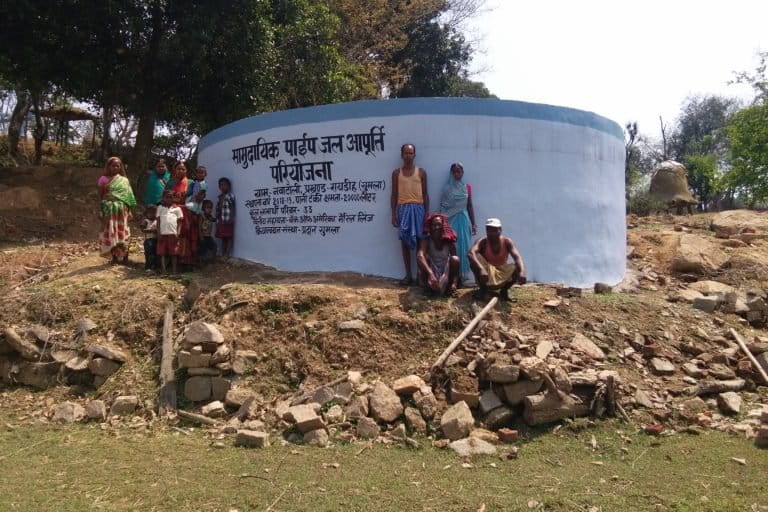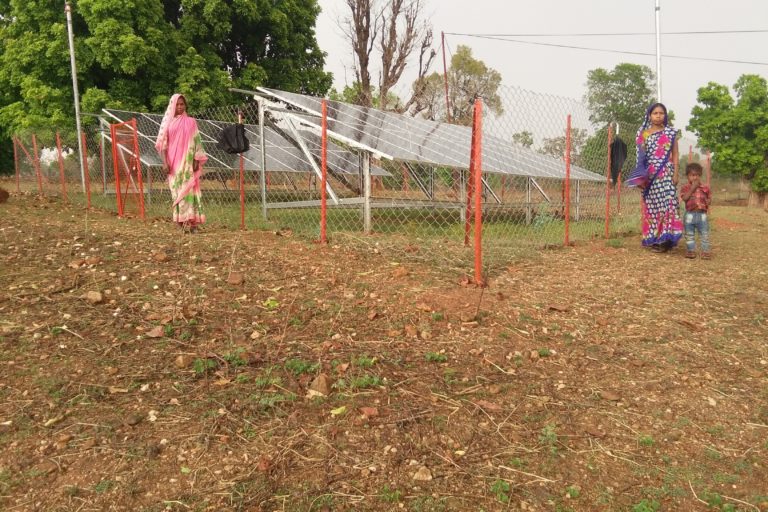- Solar power-driven irrigation has helped farmers in Jharkand villages to break their dependence on the monsoon and grow multiple crops.
- Additionally, solar microgrids are supplying electricity to homes that formerly had limited supply and solar panels on wells are ensuring regular water supply to households.
- The adoption of solar energy has helped farmers boost income, reduce work burden on women and enhanced the lifestyle of villages in Jharkhand.
A resident of Dhangaon village in Jharkhand’s Gumla district, Anirudh Gope used to cultivate paddy during monsoon on his one-acre farm. He was bound by seasonal farming and single-crop cultivation that relied on the rains for irrigation. However, when a solar-powered lift irrigation project was launched in the village in April 2019, Gope was able to transition to growing multiple crops to augment his income. Currently, he grows watermelons, wheat, peas and tomatoes.
The project has opened up the option of irrigation for the farmers, which has changed their fortunes. “In the absence of rainfall, farmers lift water from the nearby Dhangaon Gaja Toli dam. The weekly cost of irrigation stands at Rs. 250-300 roughly. There is a fixed rate of Rs. 30 per hour,” he said.
Another resident, Mungia Devi, cultivates mangoes and strawberries. “Now, we can easily fetch water from the dam, which is about 400 metres away, she informed. Another farmer, Radhe Shyam Baradih explained that before the advent of solar power in their lives, farmers could not grow crops for six months in a year and rearing cattle was the only option. “Now, we can cultivate wheat and vegetables. On my 1.5 acres of land, I have grown beans, peas and cauliflowers,” Baradih said.
Solar infrastructure projects offer a host of benefits to people in villages Srihari Chity, team coordinator for resource mobilisation, communications and partnerships at PRADAN (Professional Assistance for Development Action), a grassroots level non-profit, tells Mongabay-India.
Apart from irrigation, solar panels atop wells supply drinking water to households and solar microgrids light up homes. PRADAN is the implementing partner of this project in Jharkhand aided by its technical partner, Gram Oorja Solutions Private Limited, which is responsible for grid installations.
“In 2016-17, PRADAN started a project with the Tata Trusts in Khunti district to supply solar energy. The Bank of America agreed to fund a similar project in Gumla. Now, we have also extended it to Godda district in the Santhal Parganas,” Chity added.
Prasanna Jha, part of PRADAN’s team in Godda, said that the process of launching solar lift irrigation is on in a few villages in the district. “We wanted to boost the income of farmers, as PRADAN works for rural livelihood options. In Godda, farmers gradually gave up diesel pump sets for irrigation after fuel prices soared.” Godda is one of the six districts in the Santhal Parganas. In several villages in this region, electricity poles are still absent, Jha added.

In Godda’s Mahuatarn village, resident Master Murmu said that due to the lack of irrigation water, we decided to have solar lift irrigation. Murmu informed currently pipes are being laid and it may take up to a week for the work to achieve completion. Another resident Jasinta Besra said there is a large check dam nearby. “So, we thought that solar lift irrigation will be a good option as diesel is too costly.”
Water, water everywhere
In Jana village of Gumla district, Sukhanti Oraon has to turn on the kitchen tap to get piped water supply for cooking. Before the solar project to facilitate drinking water for homes, came to her village, she used to fetch water from wells for drinking as well as for household chores. Wells have now been cemented at the top and solar panels fitted on them. Pipes are connected from the wells to the water tank from where water is then supplied to each household. There is fixed supply time in the morning and evening, which helps conserve water.
In Gumla, the solar microgrid project has entered its fourth phase (2019-20) after starting off in 2016-17. Gumla block currently has five villages and Raidih 11 villages under the solar microgrid, covering a total population of 3343 in 4003 households. Seventeen villages are using solar-based lift irrigation and in eight villages, there is a solar-based drinking water system.
Related: How farmers in this Gujarat village use and sell clean energy.
And then there was light…
Aside from irrigation and supplying drinking water, the project has a solar microgrid that’s lighting up homes. “Even though we had power lines, we got electric supply only for 10-12 days in a year. There was darkness all around. After the solar microgrid started working, I purchased mixer grinder, fans and TV. I pay up to Rs. 250 per month for power,” said Debmani Devi of Jana village. Devi added that Rs. 100 is the fixed rate for electricity, over and above which the charge is Rs. 10 per unit.
Anjan Kasi Toli village chief Ranjan Oraon narrated how his children found it hard to study in the kerosene lamp and his wife had to cook in the dim smoke-filled kitchen. “Now, I have lights and fans in all my four rooms, apart from a TV set and mixer grinder.”

Oraon recalls the initial excitement when the project was launched. The residents collected Rs 1,000 per head from 65 families, which amounted to Rs 65,000 in total. There are 51 solar panels in the village, besides a control room. The villagers also helped labourers during the construction phase. Today, Oraon’s electricity bills range from Rs 150 to Rs 200 per month.
Anjan Kasi Toli has a committee, which looks after the maintenance work. Resident Premchand Oraon informed there are nine members in it. “We took out rallies for ensuring power supply, but nothing happened for years. After that the solar microgrid transformed our lives,” he said.
Solar microgrids comprise panels and control rooms. The total budget is Rs 28 lakh for a whole set up. The panel life is 25 years and batteries have to be replaced every five years. Committees have been formed in every village for maintenance and repair.
Jharkhand-based regional executive Bibhubanta Barad of PRADAN said as Gumla is a tribal district, many interior villages lacked power connection. So, a few villages were chosen for the solar project.
Spreading solar power
Besides Gumla, there have been three kinds of solar power interventions in Khunti district too. These are household power supply through solar microgrids in nine villages, solar-based drinking water supply in four villages and solar lift irrigation projects in 11 villages, said Rajani Kant Pandey, team coordinator at PRADAN in Khunti. This year also, micro-lift irrigation projects are on in Khunti in six irrigation sites, he added.

Saridkel resident Kalyan Munda said solar lift irrigation has increased his income from a monthly earning of Rs 2,000-3,000 to Rs 10,000-12,000. His plot of land is far away from the river and he had to use a diesel pump set to irrigate his fields. Now, he pays Rs 25 per hour for using solar lift irrigation.
According to Pratha Jhawar, deputy programme manager at Delhi-based Centre for Science and Environment, “Despite grids reaching every household in the country, the reliability of electricity, both in terms of quantity and quality, still remains a question. There is 100 percent household electrification in Jharkhand. But people living in the hinterlands face acute problems. The situation worsens during the evenings, which is the time for peak demand (5 pm–11 pm).” In Hazaribagh district for example, a report, by Prayas (Energy Group) says that the domestic customers of Bhatbigha in the district received electricity supply for an average of 02:36 hours during 6 hours in the evening for October 2019.
Jhawar added that solar-based mini-grids are filling such gaps and transforming the lives of rural people, who have mostly lived their lives in darkness. “Solar pumps are helping farmers shift from costly and polluting diesel pump sets to a dependable source of daytime power.”
Banner image: The solar electrification grid at Kashitoli Gumla block. Photo courtesy PRADAN.
